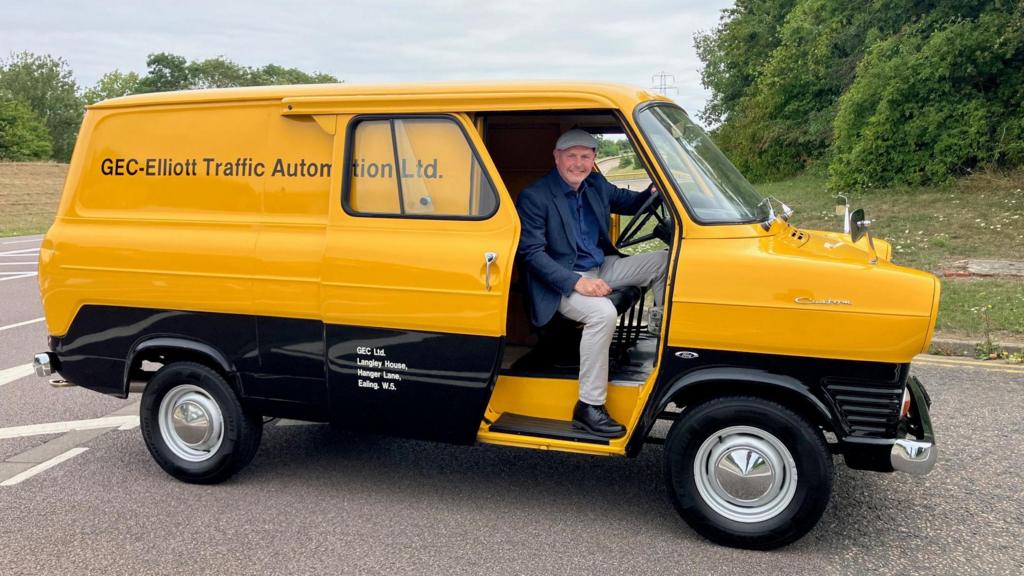Climbing into a 1965 Ford Transit offers a unique glimpse into automotive history.
Modern conveniences like satellite navigation and touchscreens are absent. Occupants are met with a steering wheel, a prominent chrome-lined speedometer, and robust heater controls. A radio is notably missing.
On the road, the vehicle produces a symphony of rattles and bangs, occasionally disengaging from gear.
The absence of seatbelts, a seat prone to unexpected movement, and seemingly ineffective brakes contribute to a disconcerting driving experience.
Despite its charm, it’s challenging to imagine this vintage machine as a cutting-edge vehicle of its time.
Yet, when the original Transit debuted from Ford’s Langley, Berkshire plant on August 9, 1965, it was revolutionary.
By the standards of the era, it offered remarkable space, power, and practicality. Its comfortable ride and sharp handling overshadowed competitors like the Morris J4.
Six decades later, the Transit has undergone numerous redesigns, but the brand remains a strong presence. It’s a mainstay for small businesses, even amidst intense competition in the “white van” market.
As the world’s best-selling van, over 13 million units have been produced to date.
Edmund King, president of the AA, notes, “There are many iconic cars: the Morris Minor, the Mini, the Land Rover, the VW Beetle, but the Transit is the only truly iconic van.”
“It’s arguably the only van that enjoys widespread public recognition.”
The Transit, a collaborative effort between Ford’s UK and German engineers, was designed for versatility, primarily targeting British and European markets.
It quickly became essential for tradespeople, including builders, carpenters, electricians, and delivery drivers.
Its spaciousness and affordability also appealed to others, including aspiring rock bands, making it almost a rite of passage. Notable bands who toured in a Transit include Black Sabbath, Led Zeppelin, The Damned, the Small Faces, and Slade.
Peter Lee, founder of the Transit Van Club, recalls, “It offered the freedom to travel anywhere, anytime. Petrol was far more affordable then.”
“I ended up in Spain, living in a Transit for 13 months as a hippy on a strawberry farm, before returning and starting a business. Eventually, I managed 180 workers in 28 Transit vans across London.”
The Transit’s speed and cargo capacity also attracted individuals engaged in illicit activities.
In 1972, a Metropolitan Police spokesman reportedly claimed that Transits were involved in 95% of bank robberies, citing their speed and cargo space as ideal for getaways, dryly dubbing it “Britain’s most wanted van.”
While the stereotype of the aggressive “white van man,” defined by Sunday Times reporter Jonathan Leake in 1997 as “a tattooed individual, often with a cigarette, prone to flashing lights,” didn’t exclusively target Transit drivers.
Given the Transit’s prevalence, it’s reasonable to assume their involvement.
For nearly half a century, Transits were manufactured in Britain, initially in Langley, then near Southampton. However, the latter closed in 2013, as Ford relocated production to Turkey, citing significantly lower costs, a controversial decision that resulted in job losses. Unions condemned the move as a ‘betrayal’.
Today, Ford emphasizes the Transit’s British heritage and ongoing UK operations, particularly at its Dunton, Essex headquarters.
Lisa Brankin, Ford of Britain’s managing director, asserts, “Dunton is the home of the Transit.”
“We manage all engineering and design for the new vans there. Our diesel engines are built in Dagenham, nearby, and we produce power packs for electric vans in Halewood, near Liverpool.”
Most of the company’s European production remains in Turkey, and changes are unlikely.
Ms. Brankin explains, “It’s about efficiency and centralizing manufacturing, rather than having multiple sites across Europe.”
Dunton’s current focus is on the next generation of Transit vans. But will there be another groundbreaking model like the original?
Seamus McDermott, director of commercial vehicle development, responds, “We’re working on it.”
He believes customer expectations for vans remain consistent over 60 years: a reliable, versatile, and cost-effective vehicle. However, the methods for achieving this have evolved significantly.
“Electric vehicles offer lower running and repair costs,” he says.
“Additionally, the introduction of more software-defined, ‘smarter’ vehicles will enable remote fleet management, reducing costs. The revolution lies in propulsion and software.”
According to AA president Edmund King, despite the Transit’s 60-year legacy, its future is uncertain.
“In the 60s, 70s, and 80s, Transit ownership often followed family tradition,” he says.
“That’s changing. Increased competition in the van market has weakened brand loyalty.”
The Vehicle Test Centre is no longer allowing learners to use the grounds during working hours.
Driving instructors in Lincolnshire say more people are choosing to learn in automatic vehicles.
It is the latest indication of the impact of US President Donald Trump’s tariffs on big American firms.
The A616 at Crow Edge near Barnsley will see its speed limit cut and parking restrictions imposed.
Sir Malcolm Campbell’s Blue Bird returns to Pendine Sands for the 100th anniversary of the record.

